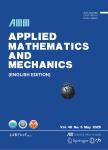版权所有:内蒙古大学图书馆 技术提供:维普资讯• 智图
内蒙古自治区呼和浩特市赛罕区大学西街235号 邮编: 010021

作者机构:School of Natural and Applied Science Northwestern Polytechnical University School of Aeronautics Northwestern Polytechnical University Ministry of Industry and Information Technology(MIIT) Key Laboratory of Dynamics and Control of Complex Systems Northwestern Polytechnical University Department of Engineering Mechanics Northwestern Polytechnical University
出 版 物:《Applied Mathematics and Mechanics(English Edition)》 (应用数学和力学(英文版))
年 卷 期:2019年第40卷第1期
页 面:111-126页
核心收录:
学科分类:08[工学] 080101[工学-一般力学与力学基础] 0801[工学-力学(可授工学、理学学位)]
基 金:Project supported by the National Natural Science Foundation of China(Nos.91648101 and11672233) the Northwestern Polytechnical University(NPU)Foundation for Fundamental Research(No.3102017AX008) the National Training Program of Innovation and Entrepreneurship for Undergraduates(No.S201710699033)
主 题:robotic dynamics multibody system symplectic method particle swarm optimization(PSO)algorithm instantaneous optimal control
摘 要:Multibody system dynamics provides a strong tool for the estimation of dynamic performances and the optimization of multisystem robot design. It can be described with differential algebraic equations(DAEs). In this paper, a particle swarm optimization(PSO) method is introduced to solve and control a symplectic multibody system for the first time. It is first combined with the symplectic method to solve problems in uncontrolled and controlled robotic arm systems. It is shown that the results conserve the energy and keep the constraints of the chaotic motion, which demonstrates the efficiency, accuracy, and time-saving ability of the method. To make the system move along the pre-planned path, which is a functional extremum problem, a double-PSO-based instantaneous optimal control is introduced. Examples are performed to test the effectiveness of the double-PSO-based instantaneous optimal control. The results show that the method has high accuracy, a fast convergence speed, and a wide range of *** the above verify the immense potential applications of the PSO method in multibody system dynamics.